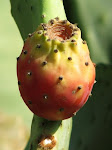'Ibrik' is a turkish word referring to a little hand hammered copper pot used for making black turkish coffee. This pot (holds one or two servings) usually comes with a long brass, wooden or ceramic handle, and a spout through which the liquid can be poured. The arabs and the israelis call it 'fengian', the Greek, 'briki'.
Coffee , as we all know, crosses borders and cultures, and it's always an interesting, loved subject.
There's a coffee shop in the center of my hometown which keeps a stand outside, near the entrance, with some twenty-five such pots. ( it looks a bit like a Christmas tree with ornaments).At first, I thought it's just a gimmick to attract customers, but no, the pots are for sale, and for quite a high price.
I always keep an ibrik in my kitchen; mine is made of stainless steel, not of copper, and it's not hand hammered.
I rarely drink turkish coffee these days, but I sometimes make it for guests who love this kind of black liquid.
I put the three-four components:cold water, coffee, sugar and or milk into the ibrik; place the little pot on the stove's lowest fire and wait until foaming begins. The foam gets put into the tiny coffee cups. I wait again till boiling starts for a second time, and immediately (without boiling) remove the ibrik to serve the coffee in the little cups. Turkish coffee is being served with a glass of cold water to enjoy the coffee better.
It may sound simple, but to make good, genuine turkish coffee is an art not easily mastered, and certainly not by anyone. There are annual regional and national organized contests in many parts of the world, and there is a world wide contest named 'the ibrik championship'(see its logo in the header above). It's considered one of the most fascinating individual contests.
Last year's golden medal (competition held in Budapest, Hungary) went to a young India born contestant, working in Dubai. This year's champion is Slava Babych of Ukraine.
Here's a little youtube video with Slava.
I rarely drink turkish coffee these days, but I sometimes make it for guests who love this kind of black liquid.
I put the three-four components:cold water, coffee, sugar and or milk into the ibrik; place the little pot on the stove's lowest fire and wait until foaming begins. The foam gets put into the tiny coffee cups. I wait again till boiling starts for a second time, and immediately (without boiling) remove the ibrik to serve the coffee in the little cups. Turkish coffee is being served with a glass of cold water to enjoy the coffee better.
It may sound simple, but to make good, genuine turkish coffee is an art not easily mastered, and certainly not by anyone. There are annual regional and national organized contests in many parts of the world, and there is a world wide contest named 'the ibrik championship'(see its logo in the header above). It's considered one of the most fascinating individual contests.
Last year's golden medal (competition held in Budapest, Hungary) went to a young India born contestant, working in Dubai. This year's champion is Slava Babych of Ukraine.
Here's a little youtube video with Slava.
















